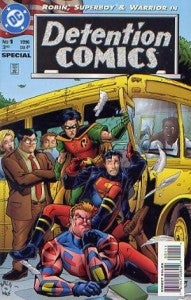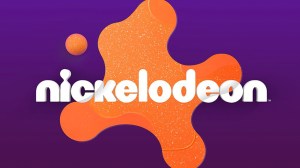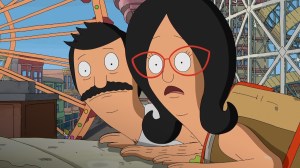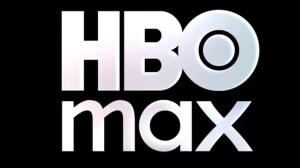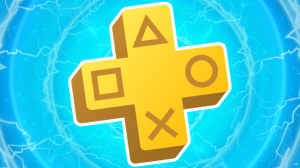About three weeks before the DC Universe was reborn and the company’s entire line was relaunched with new #1 issues in September, we ran a story about what we hoped to see in the new DC Universe. It’s now been just under seven months–enough time to really digest the sixth issues of many of the DC titles and evaluate how they did, what they could improve–and what good stuff we failed to see coming.Innovative and original takes on niche/cult characters Grade: A- The three examples used in the original article–Aquaman, Firestorm and Captain Marvel–have all been reinvented for the New 52, with varying results. While we haven’t seen much of Shazam (the character formerly known as Captain Marvel) yet, he seems to have a somewhat broader appeal in the new story but that comes at the cost of changes to the character which are likely to alienate the core group of fans. Aquaman is an unqualified success on the scale of Geoff Johns’ Green Lantern, taking character who went from being either ignored or reviled to being consistently one of the company’s top ten sellers. Fans are loving Johns’ take on the character, which allows for the silliness of a guy who talks to fish, but doesn’t embrace that silliness or even try to confront it. It just lets it exist, and then moves past it with a strong story, great characterization and terrific art. The Fury of Firestorm, meanwhile, has struggled. It’s already lost co-writer Gail Simone, replaced by Joe Harris, and while Ethan Van Sciver’s art is sure to draw some eyes in for the next few months, he’s not going to be able to sustain a monthly book forever and the chances are good those sales will revert right back to normal once the regular art team resumes their duties–especially if the writing is as bad under Harris/Van Sciver as it was under Simone/Van Sciver. In our initial New 52 Review Revue back when the book came out suggested that the first issue wasn’t a great point of departure for great success, and reviewer Nick Winstead gave it a D.Balancing the “New” with keeping the characters familiar Grade: B Aside from some very notable failures in the form of Static Shock and The Fury of Firestorm–which reinvented the wheel for their characters and somehow came away with a flat tire–DC has largely succeeded in capitalizing on what makes their characters special and keeping that front and center even as they reinvent the world around them. Superman, Batman and Wonder Woman are all as interesting now as they have been in ten or more years. A few weak spots come in, however, when you have writers who are trying to do something “bold” and “cool” with a character, only to realize that maybe “bold and cool” was what they already had and it didn’t need changing. As we mentioned in a recent review, Blue Beetle seems to have lost a lot of the originality that it had when created, as Jaime becomes more tortured and has increasingly to deal with the fact that his Scarab makes him an outsider and won’t let him reveal his secret to his family or friends. There is virtually nothing familiar in Teen Titans and, while that book isn’t bad, it isn’t exactly thrilling fans every month. Its spinoff The Ravagers seems (if Internet chatter means anything) likely to sell the least of all the “Second Wave” titles. And, of course, there are nagging issues in terms of how Batman (in the most recent issue) and more especially Green Lantern are written in Justice League.A focus on supporting characters Grade: C While DC writers talked quite a bit about giving their characters a chance to flesh out the world around them before jumping right into the crossover madness, it seems as though nobody outside of Superman or The Flash have talked to another living human who wasn’t in costume since the New 52 began. That might be splitting hairs, of course–books like Wonder Woman focus on a world where more or less every character is either an ally or an enemy in the fight and have very little room for traditional supporting characters–but many of the books seem to just be ignoring the idea altogether. J.T. Krul–and then Dan Jurgens and Keith Giffen–did their best to give Oliver Queen a batch of interesting supporting characters in Green Arrow, but there was so much happening, and the book was so poorly received, that none of them really shone. Jurgens’ Justice League International did much better, allowing a couple of non-superheroes into the clubhouse in the form of United Nations liaisons, but then those characters were blowed up but good. George Perez’s Superman has done a great job with it so far–something that both interviews and solicitations have promised that Keith Giffen and Dan Jurgens intend to continue. As has The Flash, where Brian Buccellatto and Francis Manapul have crafted an exciting and kinetic book while still focusing on what makes Barry tick and introducing us to the people and world around him nicely. That one is particularly notable as being well-needed; since Barry’s return he’s been so shallow and boring that, until the New 52, it was amost impossible to justify losing Wally West in order to get him back.Use team books, NOT solo books, for teams and universe-level events Grade: B- While by and large, the New 52 has so far been a journey of getting to know the heroes and seeing them fight their first big battles, notable exceptions have been made in this rule and a number of books have been affected. The Bat-titles have had the silent thread of the Court of Owls running through them all along so far and in the coming months they’ll be completely taken over by that crossover. Similarly, the Superman family of books and the “Young Justice” chunk of the DC lineup will all see inter-book crossovers that include both the team and the solo titles.Focus on one-in-done stories or short arcs Grade: D Most of the New 52 comics haven’t felt as “padded” or “decompressed as their pre-relaunch counterparts–but that doesn’t mean that they’ve been much more accessible to new readers who might stumble in at issue #2 or #3, having heard good things from their friends. Much was made about the fact that DC was no longer mandating six-issue arcs to writers, who would then be able to focus on telling their stories and letting the collections department worry about how to release the books. When the first round of New 52 collected editions were announced and solicited, most of the books collected their series first arcs–#1-6.An anthology series, done right Grade: B+ While the first few stories in DC Universe Presents have been entertaining and have helped to set the stage for those characters’ roles in the world of the New 52, it hardly feels like a true anthology series as it’ll only feature three different tales in the first year. That said, the creative teams have been great, the ideas and choices of properties have been good, and the book has been well-enough-done that anyone who gives it a chance will probably stick it out for a while.Would we rather see something more like Wednesday Comics or The Brave and the Bold? Maybe–but for now, it’s hard to fault a book that’s been so good.A digital anthology series or digital discounts Grade: C- No changes have been made to DC’s originally-announced digital plans, and they’re actually starting to fall behind Marvel now. The House of Ideas has not only announced Augmented Reality comics, but also begun including–at no additional charge–digital redemption codes in all of their $3.99 books. meanwhile, the only books DC have got combo packs for yet ARE $3.99 books–but you’ve got to pay an extra buck for the digital edition, making Justice League and Action Comics more expensive than most of Marvel’s titles. The only exception are their digital-first titles, which are being released weekly and inexpensively, followed by a print edition at the end of the month. That was an unexpected move, and as the variety grows it will be interesting to see how the model fits into DC’s future.A good weekly comic Grade: A This is where they really get credit for that digital-first program. The Unlimited titles have been great and Smallville is much-anticipated, and as we asked back in August, DC has focused on making their weekly releases good, rather than “important.” So far, none of the books are even in-continuity! It’s not how we pictured it, but it works for us.Subscriptions and subscription pricing Grade: D Ironically, this came back in the form of a print option, not digital as we had hoped. At first, it offered access to something like 40 of the New 52 titles as well as DC’s all-ages books. Now, the subscription form seems to have dropped to just 21 titles. given that most of the titles originally not included on the subscription form were the ones canceled to make way for the Second Wave titles, this new move may suggest that almost no one is safe from cancellation, with titles like Animal Man, Justice League International and even Aquaman unavailable at present.Broader device support for digital comics Grade: C While ComiXology did recently have a widely-publicized upgrade, it was really just a tweak to presentation on the already-supported devices. Nothing new has been added to the DC app’s list of supported devices except Amazon’s Kindle Fire, which was designed as an Android device with apps like ComiXology in mind. Those of us reading on our Nook Tablets still have little or not option for digital comics, especially as the recent upgrade didn’t improve the slipshod way comics display on a full-sized computer monitor.
The DC Comics Relaunch Report Card
About three weeks before the DC Universe was reborn and the company’s entire line was relaunched […]


